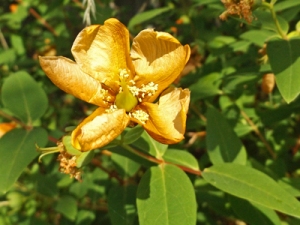We have been here almost 10 years and started pretty much with a blank canvass of 2 lawns, and when we started digging it was clear the soil was very poor, and worse! We are on good old Oxford clay but it is also quite stony.
Once the 2 gardens were set out, one the kitchen garden and the other lawn/shrubbery/flower garden, we had one big load of manure to spread about and dig in. As we have chickens, over the years they have contributed considerably to improving the soil, but every year we still add bag fulls of manure in some form or another so we can grow pretty much anything. Acid lovers, like acers, I grow in pots. Hydrangeas are happy in the ground, but of course will only be pink, not blue because of the soil here.
However, this year all this added soil improver had not been enough to stop our ground turning into concrete with cracks that you could get your hand down. Everything started off very promising but once we got towards the end of July the garden really started to shut down. No amount of watering could really keep up against the heat so we concentrated on keeping the pots, greenhouse and some of the veg watered. We have a number of water butts around the garden which lasted about 2 weeks and we are on a water meter so it became very restricting the amount of tap water we ran off.
Lavender, Phlomis, Sisyrinchium, perennial geraniums, Centaurea, Achillea, Alchemilla mollis, Eryngium, Cistus, Echinops, all tolerated the heat but didn’t flower for very long. Hollyhocks stopped flowering half way up their stems, and after the first flush of roses, they stopped flowering completely. Crocosmia leaves dried up and there are very few flower heads. Euphorbia ‘Fireglow’ died off completely, even though I was watering it. Centranthus, on the other hand, seemed oblivious to the heat and carried on regardless, as did Aquilegia.
The well established shrubs survived ok. Some hydrangeas wilted a bit so I ran the hose on them and they rallied. Unfortunately our Magnolia stellata gave up, which I am very sad about.
Interestingly, now we have had some rain and lower temperatures, one of our roses is a mass of buds so that is pleasing and some of the ground cover plants are starting to recover.
The fig tree has gone bonkers and produced masses of figs. Now all we need is the sunshine to ripen them!!!!!!
from Jennie Moss, August 2018





